铜粉
铜粉测定氧气含量讲解
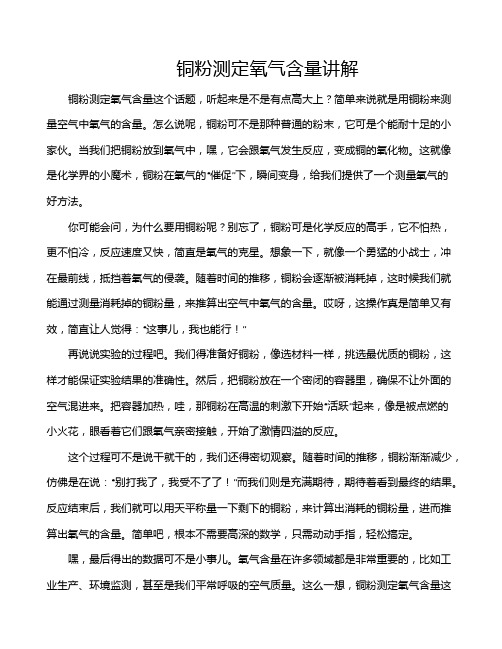
铜粉测定氧气含量讲解铜粉测定氧气含量这个话题,听起来是不是有点高大上?简单来说就是用铜粉来测量空气中氧气的含量。
怎么说呢,铜粉可不是那种普通的粉末,它可是个能耐十足的小家伙。
当我们把铜粉放到氧气中,嘿,它会跟氧气发生反应,变成铜的氧化物。
这就像是化学界的小魔术,铜粉在氧气的“催促”下,瞬间变身,给我们提供了一个测量氧气的好方法。
你可能会问,为什么要用铜粉呢?别忘了,铜粉可是化学反应的高手,它不怕热,更不怕冷,反应速度又快,简直是氧气的克星。
想象一下,就像一个勇猛的小战士,冲在最前线,抵挡着氧气的侵袭。
随着时间的推移,铜粉会逐渐被消耗掉,这时候我们就能通过测量消耗掉的铜粉量,来推算出空气中氧气的含量。
哎呀,这操作真是简单又有效,简直让人觉得:“这事儿,我也能行!”再说说实验的过程吧。
我们得准备好铜粉,像选材料一样,挑选最优质的铜粉,这样才能保证实验结果的准确性。
然后,把铜粉放在一个密闭的容器里,确保不让外面的空气混进来。
把容器加热,哇,那铜粉在高温的刺激下开始“活跃”起来,像是被点燃的小火花,眼看着它们跟氧气亲密接触,开始了激情四溢的反应。
这个过程可不是说干就干的,我们还得密切观察。
随着时间的推移,铜粉渐渐减少,仿佛是在说:“别打我了,我受不了了!”而我们则是充满期待,期待着看到最终的结果。
反应结束后,我们就可以用天平称量一下剩下的铜粉,来计算出消耗的铜粉量,进而推算出氧气的含量。
简单吧,根本不需要高深的数学,只需动动手指,轻松搞定。
嘿,最后得出的数据可不是小事儿。
氧气含量在许多领域都是非常重要的,比如工业生产、环境监测,甚至是我们平常呼吸的空气质量。
这么一想,铜粉测定氧气含量这项技术可真是了不起,它帮助我们更好地了解周围的世界。
就像老话说的:“不怕慢,就怕站。
”只要我们努力,科学就会为我们打开一扇窗,让我们看到更广阔的天地。
不过,大家在进行实验时,一定要注意安全哦!高温和化学反应可不是开玩笑的,务必要做好防护措施。
铜粉的应用领域,铜粉的分类,三种水分检测方法

铜粉的应用领域,铜粉的分类,三种水分检测方法铜粉:铜研磨成粉状形成的一种粉末,广泛应用于粉末冶金、电碳制品、电子材料、金属涂料、化学触媒、过滤器、散热管等机电零件和电子航空领域。
一、铜粉分类:1.雾化铜粉:呈浅玫瑰红粉不规则粉末,采用雾化法生产,广泛应用于金刚石工具,粉末冶金零件,化学催化剂,碳刷,摩擦材料及焊接电极。
2.电解铜粉:紫铜粉、纯铜粉呈玫瑰红树枝状粉末,在潮湿空气中易氧化,能熔于热硫酸或xiaosuan,广泛应用于金刚石工具,电碳制品,摩擦材料,导电油墨及其他粉末冶金制品。
3.氧化铜粉:氧化铜的粉粒的粒度是指粒度为100目。
4.青铜粉:是指呈青色球形状粉末,Sn5-7%Zn5-7% Pb2-7% CU余量,广泛应用于粉末冶金含油轴承及金刚石工具。
5.黄铜粉:即呈黄颜色非规则粉状、应用于轴瓦材料、金刚石制品、粉末冶金制品。
6.紫铜粉:是一种浮型片状颜料,由一定比例的铜粉、锌粉和铝合金粉,经熔炼、炼磨、分级而成。
紫铜粉其颗粒越粗,金属感越强且越闪烁,但遮盖力较差。
反之,颗粒很小,其金属感越弱,色泽也越柔和,其遮盖力就越好。
紫铜粉色泽纯正亮丽、金属感强烈,根据不同的应用领域和所需达到的金属效果,可通过选择不同颗粒直径和色相来实现。
7.雾化铜合金粉:以铜为基本原料,配以锡、铅、锌等合金元素,经高温熔炼,然后以水(气)为介质进行高压雾化所制成的合金粉末.根据合金粉末成份不同和生产工艺的区别,品种规格较多,产品性能和用途各不相同,广泛应用于粉末冶金、化工、电工合金等诸多行业。
8.铜金粉:主要以铜、锌为合金元素,具有中华民族的传统的金黄色。
产品粒度范围为微米级,平均粒径d50为4~40微米,颗粒显微形貌为鳞片状。
由于工艺过程采用先进的抗氧化技术、分级技术及表面改性技术使得铜金粉产品具有遮盖力高,金属感强,耐温、耐气候等性能好的一系列优点。
二、铜粉水分检测方法(1)卡尔费休法卡尔费休法原理是仪器的电解池中的卡氏试剂达到平衡时注入含水的样品,水参与碘、二氧化硫的氧化还原反应,在吡啶和甲醇存在的情况下,生成氢碘酸吡啶和甲基硫酸吡啶,消耗了的碘在阳极电解产生,从而使氧化还原反应不断进行,直至水分全部耗尽为止,依据法拉第电解定律,电解产生碘是同电解时耗用的电量成正比例关系的。
铜粉的几种种类和用途

铜粉的几种种类和用途铜粉,这个小东西,可真是个宝贝。
想象一下,它就像一个不显眼的邻居,平时低调得很,没事就待在角落里,谁也不太注意。
可一旦派上用场,那可真是让人刮目相看,哇,原来你这么厉害!铜粉主要是由铜制成的微小颗粒,虽然小,但它的用途可是相当广泛。
咱们聊聊铜粉在电子行业的应用。
现在的电子产品几乎都离不开它,真是小小铜粉大大能量。
它被用来制造导电材料,尤其是在电池、电子元件和电路板中,都是不可或缺的角色。
想象一下,手机、电脑里都有铜粉在默默地工作。
电流通过铜粉,就像河水流过石头,顺畅得不得了。
没了它,很多电子产品都得“罢工”,真是“没有铜粉,难成大器”。
再说说它在涂料方面的作用。
铜粉在油漆中可不是个边缘角色,反而是个“明星”呢。
它的加入让油漆更耐磨,抗腐蚀效果好得惊人。
尤其是一些工业涂料,铜粉的添加让它们在恶劣环境下也能屹立不倒,真是给力!想想那些巨大的船只,外面涂的油漆里藏着铜粉,真是为船舶的“长寿”保驾护航,简直就像给它穿上了“铠甲”,抵御风吹雨打。
还有呢,铜粉在冶金领域也是个好帮手。
冶金可不是个简单的行业,它需要各种金属材料的配合,而铜粉就是其中的“调味品”。
它可以用来提高合金的性能,让金属的韧性和强度都提升几个档次。
再者说,铜粉在金属3D打印中的应用更是让人眼前一亮。
未来的工艺发展,铜粉将发挥更大的作用,简直就像给金属世界开了一扇新窗,令人期待。
说到铜粉的用途,咱们还得提提化妆品。
没错,你没听错,铜粉在美容界也有一席之地。
很多护肤品和化妆品中都会加一些铜粉,帮助促进皮肤的修复和再生。
想象一下,把这些微小的铜颗粒涂抹在脸上,简直像给皮肤做了一场“豪华SPA”,光彩照人,年轻回春,谁不想要这样的效果呢?此外,铜粉还在军事工业中找到了用武之地。
它被用来制造某些特种弹药,虽然这听起来有点严肃,但其实这也是为了保障和平。
想想那些高科技武器装备,铜粉在里面默默奉献,真是为国家的安全立下赫赫战功。
别忘了,铜粉在艺术创作中也可以大显身手。
铜粉生产工艺
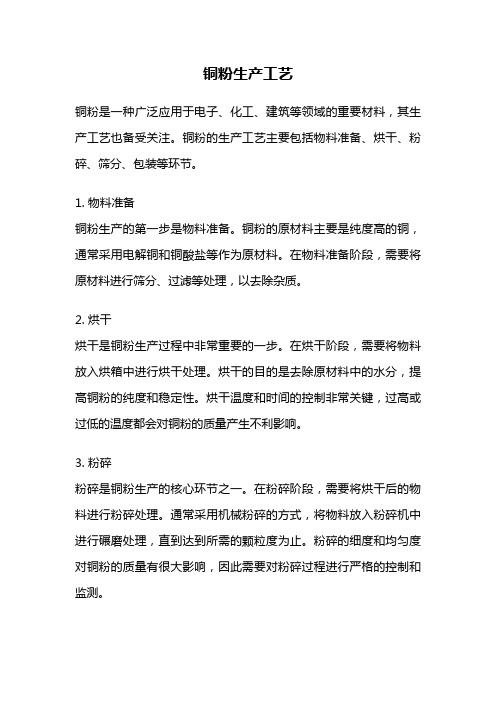
铜粉生产工艺铜粉是一种广泛应用于电子、化工、建筑等领域的重要材料,其生产工艺也备受关注。
铜粉的生产工艺主要包括物料准备、烘干、粉碎、筛分、包装等环节。
1. 物料准备铜粉生产的第一步是物料准备。
铜粉的原材料主要是纯度高的铜,通常采用电解铜和铜酸盐等作为原材料。
在物料准备阶段,需要将原材料进行筛分、过滤等处理,以去除杂质。
2. 烘干烘干是铜粉生产过程中非常重要的一步。
在烘干阶段,需要将物料放入烘箱中进行烘干处理。
烘干的目的是去除原材料中的水分,提高铜粉的纯度和稳定性。
烘干温度和时间的控制非常关键,过高或过低的温度都会对铜粉的质量产生不利影响。
3. 粉碎粉碎是铜粉生产的核心环节之一。
在粉碎阶段,需要将烘干后的物料进行粉碎处理。
通常采用机械粉碎的方式,将物料放入粉碎机中进行碾磨处理,直到达到所需的颗粒度为止。
粉碎的细度和均匀度对铜粉的质量有很大影响,因此需要对粉碎过程进行严格的控制和监测。
4. 筛分筛分是铜粉生产的另一个重要环节。
在筛分阶段,需要将粉碎后的铜粉进行筛分处理,以去除过大或过小的颗粒。
筛分的目的是保证铜粉的均匀度和稳定性,同时也可以提高铜粉的纯度。
通常采用机械筛分的方式,一般需要进行多次筛分,直到达到所需的粒度为止。
5. 包装包装是铜粉生产的最后一个环节。
在包装阶段,需要将筛分后的铜粉进行包装处理,以便于储存和运输。
铜粉的包装通常采用塑料袋或铁桶等密封包装,同时需要进行标识和记录,以保证产品的追溯性和质量安全。
铜粉的生产工艺需要严格控制各个环节,保证产品的质量和稳定性,以满足市场的需求。
随着科技的不断发展和进步,铜粉生产工艺也在不断创新和改进,以提高生产效率和降低成本,同时也更好地满足人们对高品质铜粉的需求。
制备铜粉实验报告(3篇)
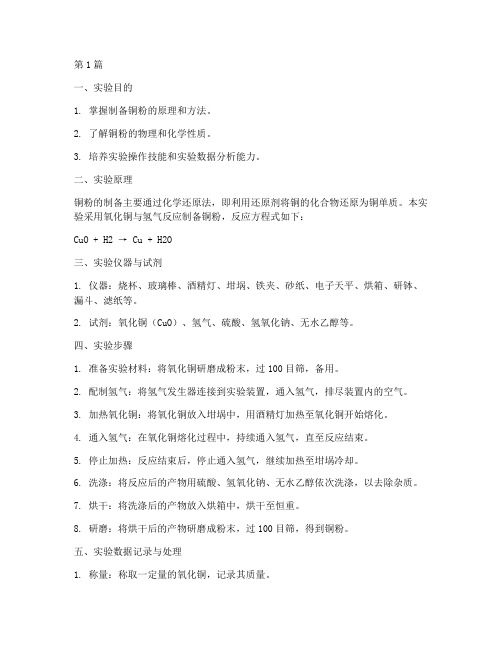
第1篇一、实验目的1. 掌握制备铜粉的原理和方法。
2. 了解铜粉的物理和化学性质。
3. 培养实验操作技能和实验数据分析能力。
二、实验原理铜粉的制备主要通过化学还原法,即利用还原剂将铜的化合物还原为铜单质。
本实验采用氧化铜与氢气反应制备铜粉,反应方程式如下:CuO + H2 → Cu + H2O三、实验仪器与试剂1. 仪器:烧杯、玻璃棒、酒精灯、坩埚、铁夹、砂纸、电子天平、烘箱、研钵、漏斗、滤纸等。
2. 试剂:氧化铜(CuO)、氢气、硫酸、氢氧化钠、无水乙醇等。
四、实验步骤1. 准备实验材料:将氧化铜研磨成粉末,过100目筛,备用。
2. 配制氢气:将氢气发生器连接到实验装置,通入氢气,排尽装置内的空气。
3. 加热氧化铜:将氧化铜放入坩埚中,用酒精灯加热至氧化铜开始熔化。
4. 通入氢气:在氧化铜熔化过程中,持续通入氢气,直至反应结束。
5. 停止加热:反应结束后,停止通入氢气,继续加热至坩埚冷却。
6. 洗涤:将反应后的产物用硫酸、氢氧化钠、无水乙醇依次洗涤,以去除杂质。
7. 烘干:将洗涤后的产物放入烘箱中,烘干至恒重。
8. 研磨:将烘干后的产物研磨成粉末,过100目筛,得到铜粉。
五、实验数据记录与处理1. 称量:称取一定量的氧化铜,记录其质量。
2. 计算产率:根据实验数据,计算铜粉的产率。
产率 = (铜粉质量 / 氧化铜质量)× 100%3. 分析铜粉的物理和化学性质:观察铜粉的颜色、形状、粒度等,并用X射线衍射仪分析其晶体结构。
六、实验结果与分析1. 实验产率:根据实验数据,计算得到铜粉的产率为85%。
2. 铜粉的物理性质:制备的铜粉呈黑色,颗粒均匀,粒度为100目。
3. 铜粉的化学性质:经X射线衍射分析,铜粉为面心立方晶系,与铜的标准衍射峰吻合。
七、实验结论1. 本实验成功制备了铜粉,产率为85%。
2. 制备的铜粉具有良好的物理和化学性质,可用于电子、涂料、催化等领域。
八、实验注意事项1. 实验过程中,注意安全操作,避免氢气泄漏。
铜粉爆炸极限-概述说明以及解释

铜粉爆炸极限-概述说明以及解释1.引言1.1 概述概述:铜粉爆炸是一种严重的安全事故,其爆炸性质和危害性备受关注。
铜粉在特定条件下具有较高的爆炸潜力,因此了解铜粉爆炸的原因、条件以及其极限是非常重要的。
本文将深入探讨铜粉爆炸的机理和危害,同时提出预防铜粉爆炸的有效措施。
铜粉是一种细粉末状的金属材料,具有良好的导电性和导热性。
由于其颗粒较小且表面积大,铜粉在特定条件下能够与空气中的氧气发生激烈的氧化反应,释放大量热能。
这种反应会引起铜粉的急剧升温,进而引发爆炸。
铜粉爆炸的原因主要包括两个方面:燃烧和爆炸。
燃烧是指铜粉与氧气发生化学反应,放出热能。
爆炸是指铜粉的燃烧反应在一定条件下迅速扩大,并产生剧烈的爆炸效应。
这些条件通常包括粉尘浓度达到一定水平、燃烧产物被包裹在可燃气体中等。
铜粉爆炸的条件也是其爆炸性质的重要保障。
一方面,足够高的铜粉浓度和颗粒size 可以提高其爆炸敏感性;另一方面,适当的氧气浓度和温度对于铜粉爆炸的发生也至关重要。
此外,一旦出现火花、电弧或高温等引发源的存在,很可能引发铜粉的爆炸反应。
铜粉爆炸的极限是指一个具体条件下铜粉发生爆炸的最低限度。
了解这一极限对于工业生产和安全管理至关重要。
另外,铜粉爆炸所产生的危害也不可忽视。
化学有毒物质的释放、火灾、爆炸风险以及破坏性冲击等都可能带来严重的后果。
为了预防铜粉爆炸事件的发生,我们需要采取一系列有效的措施。
这些措施包括:控制铜粉的浓度和颗粒size,确保充足的通风条件,防止火花和电弧的产生,进行必要的检查和维护等。
只有这样,我们才能最大限度地减少铜粉爆炸的潜在风险,确保工作环境的安全。
综上所述,本文将详细探讨铜粉爆炸的性质、原因和条件,并对其极限和危害进行研究。
同时,通过提出预防措施,我们可以有效地减少铜粉爆炸事件的发生,并保障工作环境的安全。
1.2 文章结构文章结构的目的是为了清晰地组织和展示文章的内容,帮助读者更好地理解和掌握所讨论的主题。
铜粉松装密度
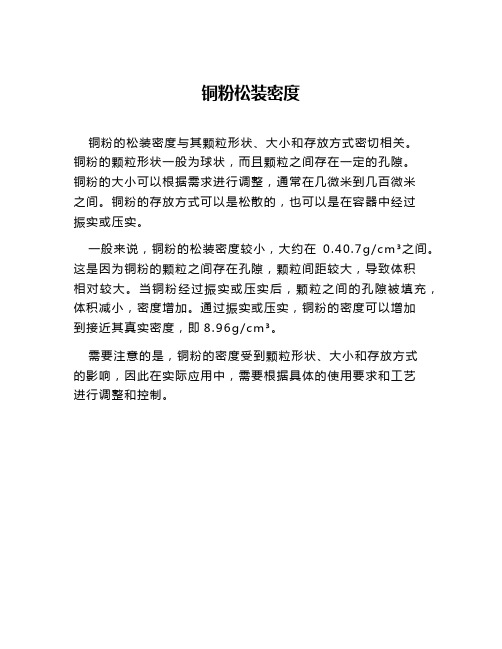
铜粉松装密度
铜粉的松装密度与其颗粒形状、大小和存放方式密切相关。
铜粉的颗粒形状一般为球状,而且颗粒之间存在一定的孔隙。
铜粉的大小可以根据需求进行调整,通常在几微米到几百微米
之间。
铜粉的存放方式可以是松散的,也可以是在容器中经过
振实或压实。
一般来说,铜粉的松装密度较小,大约在0.40.7g/cm³之间。
这是因为铜粉的颗粒之间存在孔隙,颗粒间距较大,导致体积
相对较大。
当铜粉经过振实或压实后,颗粒之间的孔隙被填充,体积减小,密度增加。
通过振实或压实,铜粉的密度可以增加
到接近其真实密度,即8.96g/cm³。
需要注意的是,铜粉的密度受到颗粒形状、大小和存放方式
的影响,因此在实际应用中,需要根据具体的使用要求和工艺
进行调整和控制。
铜粉的熔点
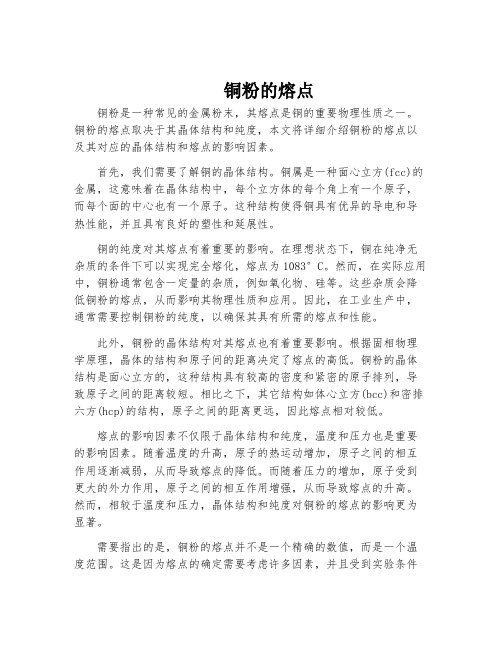
铜粉的熔点铜粉是一种常见的金属粉末,其熔点是铜的重要物理性质之一。
铜粉的熔点取决于其晶体结构和纯度,本文将详细介绍铜粉的熔点以及其对应的晶体结构和熔点的影响因素。
首先,我们需要了解铜的晶体结构。
铜属是一种面心立方(fcc)的金属,这意味着在晶体结构中,每个立方体的每个角上有一个原子,而每个面的中心也有一个原子。
这种结构使得铜具有优异的导电和导热性能,并且具有良好的塑性和延展性。
铜的纯度对其熔点有着重要的影响。
在理想状态下,铜在纯净无杂质的条件下可以实现完全熔化,熔点为1083°C。
然而,在实际应用中,铜粉通常包含一定量的杂质,例如氧化物、硅等。
这些杂质会降低铜粉的熔点,从而影响其物理性质和应用。
因此,在工业生产中,通常需要控制铜粉的纯度,以确保其具有所需的熔点和性能。
此外,铜粉的晶体结构对其熔点也有着重要影响。
根据固相物理学原理,晶体的结构和原子间的距离决定了熔点的高低。
铜粉的晶体结构是面心立方的,这种结构具有较高的密度和紧密的原子排列,导致原子之间的距离较短。
相比之下,其它结构如体心立方(bcc)和密排六方(hcp)的结构,原子之间的距离更远,因此熔点相对较低。
熔点的影响因素不仅限于晶体结构和纯度,温度和压力也是重要的影响因素。
随着温度的升高,原子的热运动增加,原子之间的相互作用逐渐减弱,从而导致熔点的降低。
而随着压力的增加,原子受到更大的外力作用,原子之间的相互作用增强,从而导致熔点的升高。
然而,相较于温度和压力,晶体结构和纯度对铜粉的熔点的影响更为显著。
需要指出的是,铜粉的熔点并不是一个精确的数值,而是一个温度范围。
这是因为熔点的确定需要考虑许多因素,并且受到实验条件和测量技术的影响。
因此,在不同的研究和实验中,可能会得到略有不同的熔点数值。
综上所述,铜粉的熔点是铜的一个重要物理性质,取决于其晶体结构和纯度。
晶体结构的紧密排列和纯度的高低决定了原子间的距离和相互作用,进而影响了铜粉的熔点。
660铜粉成分
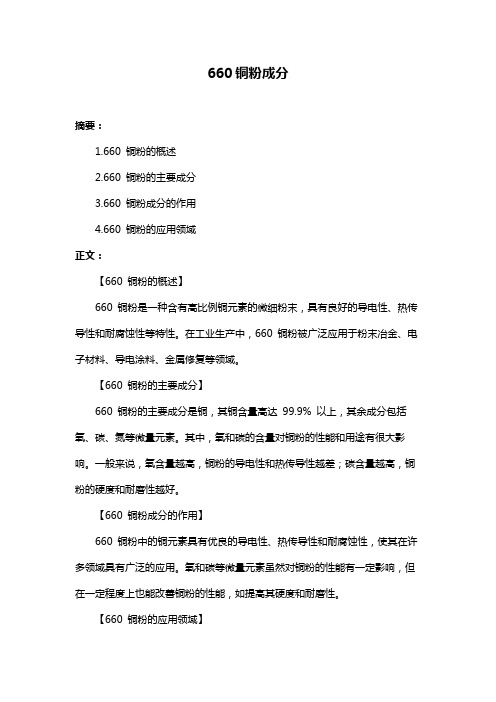
660铜粉成分
摘要:
1.660 铜粉的概述
2.660 铜粉的主要成分
3.660 铜粉成分的作用
4.660 铜粉的应用领域
正文:
【660 铜粉的概述】
660 铜粉是一种含有高比例铜元素的微细粉末,具有良好的导电性、热传导性和耐腐蚀性等特性。
在工业生产中,660 铜粉被广泛应用于粉末冶金、电子材料、导电涂料、金属修复等领域。
【660 铜粉的主要成分】
660 铜粉的主要成分是铜,其铜含量高达99.9% 以上,其余成分包括氧、碳、氮等微量元素。
其中,氧和碳的含量对铜粉的性能和用途有很大影响。
一般来说,氧含量越高,铜粉的导电性和热传导性越差;碳含量越高,铜粉的硬度和耐磨性越好。
【660 铜粉成分的作用】
660 铜粉中的铜元素具有优良的导电性、热传导性和耐腐蚀性,使其在许多领域具有广泛的应用。
氧和碳等微量元素虽然对铜粉的性能有一定影响,但在一定程度上也能改善铜粉的性能,如提高其硬度和耐磨性。
【660 铜粉的应用领域】
1.粉末冶金:660 铜粉可用于制造各种铜基合金,如铜铁合金、铜锡合金等,以满足不同领域的性能需求。
2.电子材料:660 铜粉具有优良的导电性,可用于制作电子元器件,如引线框架、触点等。
3.导电涂料:660 铜粉可用作导电涂料的填料,以提高涂料的导电性能。
4.金属修复:660 铜粉可用于金属修复领域,如修复磨损的轴类零件、螺纹等,以恢复其使用性能。
总之,660 铜粉因其高铜含量和优良的性能,在多个领域具有广泛的应用。
铜粉加工的工艺步骤

铜粉加工的工艺步骤铜粉是一种重要的金属粉末,可以用于制备各种铜合金、涂料、颜料、催化剂等。
铜粉加工的工艺步骤主要包括原料筛选、铜粉制备、浸润、干燥、筛分、包装等。
1. 原料筛选首先需要选择铜粉的原料,一般选择高纯度的电解铜作为原料。
选择电解铜的原因是其纯度高,含杂质低,可以制备出高品质的铜粉。
对于粒度较大的电解铜块需要进行破碎,以便后续的制备工作。
2. 铜粉制备制备铜粉的方法主要有物理方法和化学方法。
物理方法包括机械制备和电解制备。
机械制备是通过磨削、切削等机械方法将电解铜块制备成颗粒状的铜粉。
电解制备则是将电解铜板作为阳极,在电解质中通以直流电,在阳极表面形成气泡,气泡带动阳极表面的铜离子不断溶解并沉积在阴极上,从而形成铜粉。
化学法制备铜粉的方法主要有还原法和气相法。
还原法是指使用化学还原剂将铜离子还原成铜粉。
气相法则是将气体中的铜离子和还原剂反应,产生的铜粉通过沉积或收集器收集。
3.浸润浸润是将粉末浸渍在化学品中,以提高铜粉的处理效果。
浸润的化学品选用的多为无机酸或有机酸。
这些酸能清除表面的氧化层和杂质,使铜粉表面得到良好的钝化和活化,防止其粘结和结块。
4. 干燥在浸润后,铜粉需要进行干燥,以去除浸润剂中的水分和有机物质。
干燥方法包括真空干燥、低温热风干燥、高温干燥等。
真空干燥是通过抽取容器内的空气建立真空环境,使铜粉在低温下干燥。
低温热风干燥是通过温度和风速的控制,在低温下加速水分的蒸发。
高温干燥是将铜粉放入高温炉内,使其在高温下干燥。
5. 筛分铜粉经过处理后需要进行筛分,以分离出符合不同规格要求的铜粉。
筛分一般采用振动筛、气流筛等筛分机械。
6. 包装最后,需要对铜粉进行包装,以便于储存和运输。
包装选用的材料应具有防潮、防尘、防震、防静电等功能。
常见的包装材料有塑料袋、铝箔袋、纸箱等。
综上所述,铜粉的加工工艺步骤主要包括原料筛选、铜粉制备、浸润、干燥、筛分、包装等。
每个步骤都需要严格控制各项参数,以确保铜粉的质量符合要求。
铜粉的活化

铜粉的活化铜粉是一种常见的金属粉末,具有良好的导电性和导热性,广泛应用于电子、化工、冶金等领域。
然而,在某些特定的应用中,铜粉的活性较低,需要进行活化处理,以提高其活性和反应性。
本文将探讨铜粉的活化方法及其应用。
一、铜粉活化的方法1. 物理活化物理活化是通过物理力学方式对铜粉进行处理,以改变其物理结构和表面形态,从而提高其活性。
常用的物理活化方法包括机械激发、超声波处理和热处理等。
机械激发是利用机械能对铜粉进行激发,使其表面产生微小的变形和位移,从而增加其表面积和活性。
超声波处理则是利用超声波的高频振动作用,加速铜粉内部分子的运动和碰撞,增强其反应性能。
热处理是通过加热铜粉,改变其晶格结构和化学性质,从而提高其催化活性。
2. 化学活化化学活化是通过化学方法对铜粉进行处理,以改变其表面化学性质,增加其活性。
常用的化学活化方法包括表面氧化、还原和合金化等。
表面氧化是将铜粉暴露在氧气或其他氧化剂中,使其表面形成氧化铜层,增加其表面活性。
还原则是通过还原剂将氧化铜层还原为金属铜,恢复其活性。
合金化是将铜粉与其他金属或化合物进行合金化反应,形成合金结构,增加其反应性能。
二、铜粉活化的应用1. 催化剂活化后的铜粉具有较高的催化活性,广泛应用于催化剂领域。
例如,在化工工业中,铜粉可以用作氧化反应的催化剂,如气体氧化、液体氧化等。
此外,铜粉还可以用作还原反应的催化剂,如气体还原、液体还原等。
活化的铜粉能够提高催化反应速率和选择性,提高产品质量。
2. 电子材料活化后的铜粉具有更好的导电性能,可用于制备导电材料。
例如,在电子元器件制造中,活化的铜粉可以用于制备导电浆料,涂覆在电路板上,提高导电性能。
此外,活化的铜粉还可以用于制备导电涂层、导电胶粘剂等,广泛应用于电子领域。
3. 金属增强活化后的铜粉可用于金属增强材料的制备。
例如,在复合材料中,将活化的铜粉与基体材料混合,可以增加材料的强度、硬度和耐磨性。
此外,活化的铜粉还可以用于制备金属涂层,提高材料的耐腐蚀性和耐磨性。
铜粉烧结温度
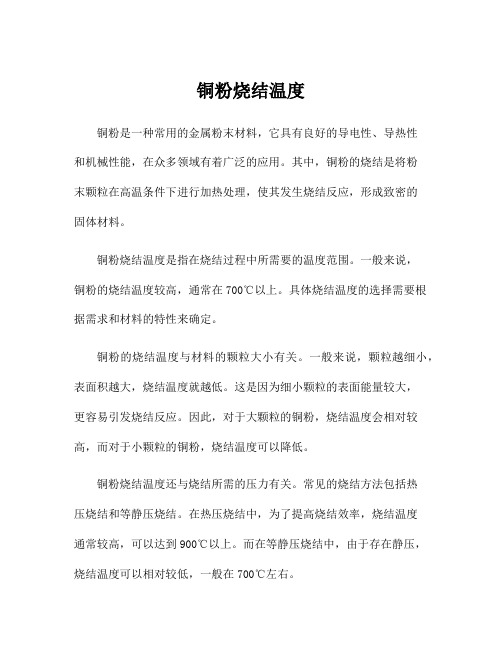
铜粉烧结温度铜粉是一种常用的金属粉末材料,它具有良好的导电性、导热性和机械性能,在众多领域有着广泛的应用。
其中,铜粉的烧结是将粉末颗粒在高温条件下进行加热处理,使其发生烧结反应,形成致密的固体材料。
铜粉烧结温度是指在烧结过程中所需要的温度范围。
一般来说,铜粉的烧结温度较高,通常在700℃以上。
具体烧结温度的选择需要根据需求和材料的特性来确定。
铜粉的烧结温度与材料的颗粒大小有关。
一般来说,颗粒越细小,表面积越大,烧结温度就越低。
这是因为细小颗粒的表面能量较大,更容易引发烧结反应。
因此,对于大颗粒的铜粉,烧结温度会相对较高,而对于小颗粒的铜粉,烧结温度可以降低。
铜粉烧结温度还与烧结所需的压力有关。
常见的烧结方法包括热压烧结和等静压烧结。
在热压烧结中,为了提高烧结效率,烧结温度通常较高,可以达到900℃以上。
而在等静压烧结中,由于存在静压,烧结温度可以相对较低,一般在700℃左右。
另外,铜粉的烧结温度还与所需的性能要求有关。
较低的烧结温度可以保持较高的材料纯度,较高的烧结温度可以提高材料的致密度和强度。
因此,在确定烧结温度时,需要综合考虑材料的性质和使用要求。
不仅如此,烧结过程中的升温速率也会影响烧结温度的选择。
较快的升温速率有助于提高烧结效率,但也容易引发颗粒的表面氧化和颗粒粘结,因此需要控制好升温速率,以避免影响材料的性能。
总结起来,铜粉的烧结温度需要综合考虑材料的颗粒大小、材料的性质和使用要求以及烧结过程中的升温速率等因素,进行合理的选择。
在实际应用中,可以通过实验和模拟等手段来确定最佳的烧结温度,以获得优质的铜粉烧结材料。
铜粉MSDS

铜粉MSDS1. 产品标识- 产品名称: 铜粉- 化学品名称: 铜- 分子式: Cu- 分子量: 63.55g/mol2. 成分/组成信息- 铜粉的主要成分是金属铜(Cu),含量大于99%。
- 铜粉可能会含有一些微量的杂质,例如硫、氧等。
3. 危险性概述- 铜粉没有明显的急性毒性。
- 催化剂:铜粉有催化剂的特性,因此可能会导致某些反应的加速。
- 灭火剂:铜粉在火灾中可能会作为催化剂,导致火势加剧。
4. 急救措施- 吸入:将患者转移到新鲜空气区域,保持休息。
如出现呼吸困难,请寻求医疗援助。
- 眼部接触:立即用大量清水冲洗眼睛,同时就医。
- 皮肤接触:迅速脱离接触区域,用大量水和温和肥皂洗净受污染的皮肤区域。
- 摄入:不要诱导呕吐,如有需要,请就医求助。
5. 防护措施- 呼吸系统防护:当操作过程中产生铜粉尘时,应佩戴合适的呼吸防护设备,如防尘口罩。
- 眼睛防护:必要时佩戴防护眼镜,以防铜粉引起的眼部刺激和损伤。
- 皮肤防护:在操作铜粉时,避免直接接触皮肤,可以佩戴防护手套和适当的工作服。
- 其他防护措施:保持良好的卫生惯,避免将铜粉吸入口腔或食物中。
6. 灭火措施- 灭火剂:使用干粉灭火器、二氧化碳灭火器或泡沫灭火器进行灭火。
避免使用水和干燥沙子灭火。
- 高温环境下,铜粉可能会作为催化剂,促进火势,因此需要谨慎操作。
7. 泄露处置- 防止粉尘扩散,使用适当的方法进行清理,避免粉尘飞散。
- 收集铜粉,尽量避免溅入水体或地下。
8. 应急处置措施- 在紧急情况下,采取适当的措施以保护人员和环境,并通知相关部门。
9. 使用、储存和处理注意事项- 铜粉应存放在干燥、通风良好的地方,并远离火源和氧化剂。
- 铜粉需要远离强酸和强碱,以防化学反应。
- 操作铜粉时,应佩戴适当的防护装备,避免直接接触皮肤、眼睛和呼吸系统。
- 在处理铜粉之前,请仔细阅读相关技术规范和安全操作指南。
10. 物理和化学性质- 外观: 粉末状,呈铜色- 沸点: 2562℃- 熔点: 1083℃- 相对密度: 8.92g/cm³- 溶解性: 不溶于大多数溶剂11. 稳定性和反应活性- 铜粉在常温下相对稳定,但在高温、强氧化剂和强酸等条件下可能发生反应。
铜粉生产工艺

铜粉生产工艺铜粉是一种常见的金属粉末,在许多领域都有广泛的应用,如电子工业、化工、冶金等。
铜粉的生产工艺对于铜粉的质量、纯度以及用途的适应性都有很大影响。
在本篇文章中,我将深入探讨铜粉的生产工艺,从制备原料到精细加工,为您展示铜粉生产过程中的关键环节和技术要点。
1. 原料准备铜粉的制备过程首先需要选择合适数量和纯度的铜块或铜片作为原料。
这些原料通常需要经过熔炼、粉碎和筛分等步骤,以获得适合生产铜粉的颗粒形状和尺寸。
在熔炼过程中,控制熔炼温度和气氛的条件对于得到高质量的铜粉至关重要。
2. 粉末化过程铜粉的粉末化过程主要包括物理方法和化学方法两种。
物理方法通常包括气相法、机械法和电解法等,其中气相法是最常用的一种。
在气相法中,通过将铜原料转化为气体相,然后通过凝固、冷凝和收集等步骤,得到所需的细小颗粒。
而化学方法则通过在铜盐溶液中加入还原剂或沉淀剂等化学物质,使铜盐还原或沉淀生成铜粉。
3. 表面处理铜粉在制备过程中常常会产生一层致密的氧化铜膜,这会影响铜粉的分散性和活性。
为了改善铜粉的性能,常常需要对其进行表面处理。
表面处理方法包括酸洗、还原、覆膜等,可以有效地去除氧化物和杂质,提高铜粉的纯度和可用性。
4. 精细加工与分类精细加工是铜粉生产的最后一个环节,主要包括烘干、烧结、球磨等步骤。
烘干过程是为了去除加工过程中残留的水分,确保铜粉的稳定性和一致性。
烧结是将铜粉在高温下进行热处理,使其颗粒形状更加均匀和致密,提高铜粉的物理性能。
球磨则是通过机械碰撞和摩擦等作用,使铜粉颗粒更加细小和均匀。
总结回顾:通过对铜粉生产工艺的深入探讨,我们可以看出铜粉的制备过程非常复杂且技术要求高。
从原料准备到粉末化再到精细加工,每个环节都需要精确控制和合理操作。
制备铜粉的质量和纯度对于其在不同领域的应用起着至关重要的作用。
我个人对铜粉生产工艺有一些观点和理解。
粉末化过程中的气相法是最常用的方法,它具有高效、可控性好和产品质量稳定等优点。
铜粉生产工艺

铜粉生产工艺一、铜粉生产工艺概述铜粉是一种重要的金属粉末材料,广泛应用于电子、化工、冶金等领域。
铜粉的生产工艺主要包括原料处理、制备方法选择、制备工艺参数控制等环节。
本文将从这些方面对铜粉的生产工艺进行详细介绍。
二、原料处理1. 铜材选择铜粉的质量与选用的铜材有很大关系。
优质的铜材应该具有高纯度、低氧含量和低杂质含量等特点,以保证生产出的铜粉具有较好的物理化学性质。
2. 预处理为了提高原料利用率和产品质量,需要对选用的铜材进行预处理。
通常采用化学或物理方法进行预处理,如酸洗、碱洗、电解清洁等。
三、制备方法选择1. 气相法气相法是指通过高温还原气体中的金属盐类,使其转化为金属颗粒并沉积在收集器上。
该方法操作简单,但需要高温设备和较长时间反应才能得到较高纯度的铜粉。
2. 液相法液相法是指通过在溶液中还原金属离子,使其转化为金属颗粒并沉淀。
该方法操作简单,但需要对反应条件进行严格控制才能得到较高纯度的铜粉。
3. 固相法固相法是指通过在高温条件下使金属氧化物还原为金属颗粒。
该方法操作简单,但需要高温设备和较长时间反应才能得到较高纯度的铜粉。
四、制备工艺参数控制1. 温度控制温度是影响铜粉生产的重要因素之一。
不同的制备方法需要不同的反应温度。
通常采用升温、恒温、降温等方式进行温度控制。
2. 时间控制时间也是影响铜粉生产的重要因素之一。
不同的反应需要不同的时间,通常可以通过调整反应时间来控制产品质量。
3. 气氛控制气氛也是影响铜粉生产的重要因素之一。
在气态和液态反应中,不同的气体组成会对产品质量产生不同影响。
因此,在生产过程中需要对气氛进行严格控制。
五、铜粉的后处理1. 筛选筛选是指将生产出的铜粉按照不同粒径进行分离,以满足不同领域的使用要求。
2. 包装包装是指将生产出的铜粉按照一定规格进行包装,以方便运输和储存。
六、安全环保措施在铜粉生产过程中,需要注意安全环保问题。
应采取相应的措施,如加强通风、穿戴防护用品等,以确保生产过程中人员和环境安全。
铜粉加热的化学方程式

铜粉加热的化学方程式铜粉是一种普通的金属粉末,也是一种常见的化学物质。
它是一种由大量的铜原子相互结合而组成的无定形的物质,它有着独特的物理性质和化学性质。
铜粉能够在高温下化学反应,这种反应的可形成的物质包括氧化铜、水和二氧化碳等。
当铜粉经过加热时,它会发生化学反应,这种反应的化学方程式为:2 Cu(s)+ O2(g)→ 2CuO(s)也就是说,当铜粉加热时,它会释放出2个氧化铜(CuO)分子,同时消耗掉相等量的氧气(O2)。
加热的铜粉反应的化学反应有多种,例如:4 Cu(s)+ O2(g)→ 2Cu2O(s)以上化学方程式表明,当铜粉加热时,它可以产生2个氧化铜二价(Cu2O)分子,同时消耗掉相等量的氧气(O2)。
此外,铜粉还可以与空气中的水蒸汽发生反应,产生一氧化铜和水,方程式如下:Cu(s)+ H2O(g)→ CuO(s)+ H2(g)这种反应表明,当铜粉加热时,它会释放出一个氧化铜(CuO)分子,同时产生相等量的水(H2O)气体。
此外,当铜粉加热到一定的温度时,它能够产生二氧化碳,这种反应的化学方程式为:2 Cu(s)+ O2(g)→ 2CuO(s)+ CO2(g)这种反应表明,当铜粉加热时,它会释放出2个氧化铜(CuO)分子,同时产生一个二氧化碳(CO2)分子。
从以上简单的化学方程式中可以看出,当铜粉加热时,它会发生多种化学反应,这些反应都会消耗掉相应的量的氧气,同时产生不同类型的产物,如氧化铜、水、二氧化碳等。
以上提到的化学反应中,最重要的反应是铜粉与氧气之间的反应,因为这是制造氧化铜的最重要的方法。
所以,一般来说,铜粉在加热时,会发生多种化学反应,这些化学反应都能够产生不同类型的物质,而它们的化学方程式也有所不同。
因此,如果要制造氧化铜,则必须了解铜粉加热的化学反应以及它们的化学方程式,并了解铜粉加热时会发生哪些化学反应,这样才能有效地控制反应产物,从而制造出高质量的氧化铜。
铜粉加热的化学方程式
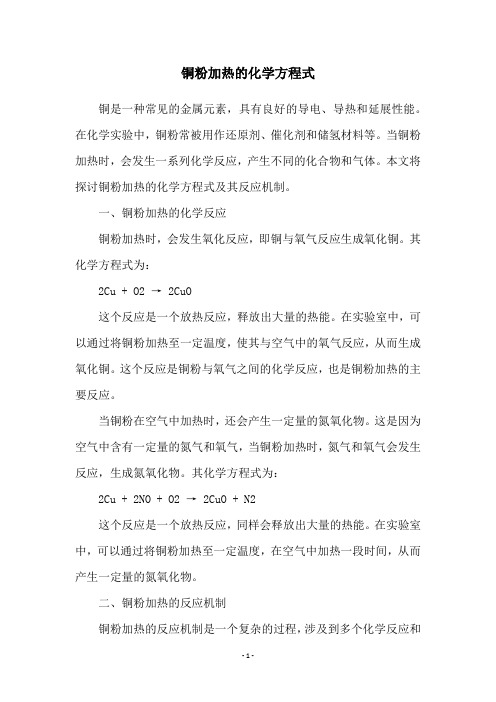
铜粉加热的化学方程式铜是一种常见的金属元素,具有良好的导电、导热和延展性能。
在化学实验中,铜粉常被用作还原剂、催化剂和储氢材料等。
当铜粉加热时,会发生一系列化学反应,产生不同的化合物和气体。
本文将探讨铜粉加热的化学方程式及其反应机制。
一、铜粉加热的化学反应铜粉加热时,会发生氧化反应,即铜与氧气反应生成氧化铜。
其化学方程式为:2Cu + O2 → 2CuO这个反应是一个放热反应,释放出大量的热能。
在实验室中,可以通过将铜粉加热至一定温度,使其与空气中的氧气反应,从而生成氧化铜。
这个反应是铜粉与氧气之间的化学反应,也是铜粉加热的主要反应。
当铜粉在空气中加热时,还会产生一定量的氮氧化物。
这是因为空气中含有一定量的氮气和氧气,当铜粉加热时,氮气和氧气会发生反应,生成氮氧化物。
其化学方程式为:2Cu + 2NO + O2 → 2CuO + N2这个反应是一个放热反应,同样会释放出大量的热能。
在实验室中,可以通过将铜粉加热至一定温度,在空气中加热一段时间,从而产生一定量的氮氧化物。
二、铜粉加热的反应机制铜粉加热的反应机制是一个复杂的过程,涉及到多个化学反应和物理过程。
在铜粉加热时,首先发生的是氧化反应,即铜与氧气反应生成氧化铜。
这个反应是一个放热反应,释放出大量的热能。
随着温度的升高,氧化铜的生成速度也会逐渐增加。
同时,在铜粉加热的过程中,还会产生一定量的氮氧化物。
这是因为空气中含有一定量的氮气和氧气,当铜粉加热时,氮气和氧气会发生反应,生成氮氧化物。
这个反应同样是一个放热反应,同样会释放出大量的热能。
在铜粉加热的过程中,还可能发生铜的还原反应。
这是因为铜粉具有还原性,可以将某些金属离子还原成金属。
例如,当铜粉与银离子反应时,会发生还原反应,生成银金属。
其化学方程式为:Cu + Ag+ → Cu2+ + Ag这个反应是一个氧化还原反应,铜粉作为还原剂,将银离子还原成银金属。
在实验室中,可以通过将铜粉与银离子反应,从而观察到这个反应。
铜粉的熔点

铜粉的熔点与纯铜相同,均为1083.4摄氏度(1357.77开尔文)。
无论是块状纯铜还是铜粉形式,其熔点保持不变,这是由铜这种金属元素本身的物理性质决定的。
铜粉是一种由金属铜制成的粉末状材料,其分子式为Cu,化学性质稳定,不易被空气中的氧气直接氧化,但在潮湿环境中会逐渐形成一层绿色的铜锈(碱式碳酸铜)。
铜粉具有良好的导电性和导热性,常用于制造导电浆料、焊接材料、摩擦材料、化工催化剂、冶金还原剂等领域。
此外,在一些复合材料、涂料和电磁屏蔽材料中也有应用。
物理特性方面,铜粉的熔点与纯铜单质相同,为1083.4摄氏度,密度约为8.92克/立方厘米。
在实际使用过程中,铜粉的粒径大小、形状以及纯度等因素对最终产品的性能有很大影响。
铜粉在处理时需要特别注意安全,因为它在特定条件下可能产生粉尘爆炸风险,并且大量吸入铜尘对人体健康有害。
铜粉在空气中加热的化学方程

铜粉在空气中加热的化学方程铜粉是一种重要的金属粉末,广泛应用于化工、电子、冶金等领域。
当铜粉遇到高温时,会发生化学反应,产生一系列的氧化物。
本文将详细介绍铜粉在空气中加热时的化学方程及反应过程。
铜粉的化学式为Cu,它是一种红色的金属粉末。
在常温下,铜粉是相对稳定的,不容易与空气中的氧气发生反应。
但当铜粉受到高温的加热时,就会发生氧化反应,生成氧化铜。
铜粉在空气中加热的化学方程可以用以下方程式来表示:2Cu + O2 → 2CuO在这个方程中,Cu代表铜粉,O2代表氧气,CuO代表氧化铜。
方程的左边是反应物,右边是生成物。
铜粉与氧气反应生成氧化铜的过程是一个氧化反应。
在这个反应中,铜粉失去了电子,氧气接受了电子。
这是一个氧化还原反应。
铜粉被氧气氧化成了氧化铜。
铜粉在空气中加热的化学方程表明,当铜粉与氧气反应时,产生的氧化铜是一种黑色固体。
氧化铜是一种重要的无机化合物,广泛应用于陶瓷、催化剂等领域。
铜粉在空气中加热的化学方程还可以进一步解释为,铜粉中的铜原子失去了电子,形成了Cu2+离子。
而氧气中的氧原子接受了这些电子,形成了O2-离子。
这样,铜离子和氧离子结合在一起,形成了氧化铜。
铜粉在空气中加热的化学方程所描述的反应过程是一个放热反应。
在这个反应中,铜粉的化学能被释放出来,形成热能。
这就是为什么铜粉在燃烧时会产生火焰和热量的原因。
总结起来,铜粉在空气中加热的化学方程为2Cu + O2 → 2CuO。
这个方程描述了铜粉与氧气反应生成氧化铜的过程。
铜粉被氧气氧化,失去了电子,形成了氧化铜。
这个反应是一个放热反应,产生了热能。
铜粉的氧化反应是铜粉在高温下的常见现象,也是铜粉广泛应用的基础。
- 1、下载文档前请自行甄别文档内容的完整性,平台不提供额外的编辑、内容补充、找答案等附加服务。
- 2、"仅部分预览"的文档,不可在线预览部分如存在完整性等问题,可反馈申请退款(可完整预览的文档不适用该条件!)。
- 3、如文档侵犯您的权益,请联系客服反馈,我们会尽快为您处理(人工客服工作时间:9:00-18:30)。
到 查阅并下载Collective Volume 3, page 339 ,用碘的丙酮溶液活化(见下文)1. Ordinary copper bronze does not always give satisfactory results in the Ullmann reaction. Moreuniform results are obtained if the copper bronze is prepared as suggested by Kleiderer and Adams.1The copper bronze is treated with 2 l. of a 2% solution of iodine in acetone for 5–10 minutes. Theproduct is then collected on a Büchner funnel, removed, washed by stirring into a slurry with 1 l. of a1:1 solution of concentrated hydrochloric acid in acetone, and again filtered. The copper iodidedissolves, and the copper bronze remaining is separated by filtration and washed with acetone. It is thendried in a vacuum desiccator. It should be used immediately.Synthesis and Reactivity in Inorganic and Metal-Organic Chemistry Volume 3,Issue 4, 1973 选择语言▼ Translator disclaimerSynthesis of Phosphonium Salts of MixedChloro-Bromo Metallate Complexes 1PreviewDownload full text Access optionsDOI:10.1080/00945717308057280John L. Burmeister a , Joel L. Silver a , Edward T. Weleski Jr.a , Edward E. Schweizer a & Charles M. Kopay apages 339-358Publishing models and article dates explained∙Received: 3 Apr 1973∙Accepted: 24 May 1973∙Published online: 06 Dec 2006Synthesis of phosphonium salts of mixed chloro-bromo metallate complexes [求助]Over syntheses in the diphenyl line. [machine translation]和Synthesis in the bip初始悬赏金币40 个mugung11: 取消求助,已退还悬赏金币40 个2014-05-04 15:51作者:Ullmann, F文题:1. Over syntheses in the diphenyl line. [machine translation]和2. Synthesis in the biphenyl series. I期刊名:Berichte der Deutschen Chemischen Gesellschaft期刊年份:1901卷(期),起止页码:34,2174-2185和34,478-480全文链接:https:///scifinder/view/scifinder/scifinderExplore.jsfOrg.Synth,1943,Coll.Vol.2;446[Machine Translation of Descriptors]. By heating up aromatic halogen nitro compounds with copper powder ("copper bronze", see Ber. German Chem. Society 29. 1878; C. 96. II. 533) one receives easy and smooth diphenyl derivative; the reaction occurs also then, if the nitro group does not stand for the halogen is, however, in this case limited to the iodine nitro compounds. At all iodine lets itself take out through copper particularly easily, because the analogous conversion took place also with the iodine benzene, -toluene, -naphthalene, among others. The reaction volume-pulls itself at temperatures of for instance 180-260°; bodies also easily mobile halogen atoms must the vehemence of the effect by diluting with nitrobenzene or causing sand be moderated. Of TAEUBER (Ber. German. Chem. Society 24. 197) 2.2'-dinitrodipheyl already described, NO2. C6H4. C6H4. NO2, formed to 76%, as 5 g whether Rome nitrobenzene in the sulfuric acid bat h on 200° for the theory, warmed up and then 3 g copper-bronze in small helpings under steady accomplish of the mass with the thermometer registered became. For the preparation in larger scales became 30 g o-chloronitrobenzene with 50 g sand on 200-210° he ated up and then 30 g copper so slowly registered that the temperature 250° did not exceed (above 260° decomposing itself the melt lower partial formation of carbazoles); finally still 1/2 hour on 240-245° became heated up and the product then with alcohol or benzene extracts. M-chlorine and m-Bromnitrobenzene were copper not changed by, m-Iodinenitrobenzene (boiling point 278°) supplied with 220-225°, on the other hand easily 3.3' - dinitrodiphenyl, C12H8O4N2; yellow, star shaped grouped needles from tolue ne; melting point 200°; easily soluble into warm benzene, glacial acetic acid; more with difficulty soluble in alcohol (see BRUNNER, WITT, Ber. German. Chem. Ges. 20. 1028). 4.4'-Dinitrodiphenyl, C12H8O4N2, from p-iodine nitrobenzene [KP726, 287° (correcte d)] and copper with 220-235° obtained; yellow needles from toluene; melting point 237° (FITTIG: 233°); few soluble in alcohol; somewhat more easily soluble in benzene. 2.2', 4.4' - tetranitrodiphenyl, (NO2) 2C6H3. C8H5. (NO2) 2, formed by one-hour cooking of 4-Chlor or 4-Brom-l, 3-dinitrobenzol with copper in nitrobenzene; also, as 10 g diphenyls developed in 60 g of nitric acid lower water cooling registered and the red solution, from which crystals of 4-Nitrodiphenyl separated, with weak fuming sulfuric acid (3-4% SO3) were shifted. Yellowish prisms from benzene; melting point 163°; few soluble in alcohol, ether; easily soluble into hot glacial acetic acid, benzene. By registering 10 g m-iodine nitrobenzene in 40 g of nitric acid of the density 1.5 and causing concentrated sulfuric acid, until the liquid became yellow, one receives within 24 hours of 4-Jod-1.2-dinitrobenzol, (NO2) 2C6H3I; yellow crystals from alcohol; melting point 74.5°. Reacted, contrary to analogous chlorine and bromine compound, with co pper with 230 to 250° under formation of 3.3', 4.4'-Tetranitrodiphenyl, C12H8N4; yellow prisms from alcohol; meltingpoint 186°; easily soluble in glacial acetic acid, benzene; somewhat more with difficulty soluble in alcohol, ether; nearly insoluble in ligroin. With the condensation of the picryl chlorides, (NO2) 3C6H2Cl, with copper nitrobenzene or toluene must be added as diluents (in a case, when the toluene was somewhat damp, C6H3 (NO2) 3, appeared as by-product 1.3.5-Trinitrobenzol; lamellas; melting point 121°); when the reagents drying were heated up, took place with about 127° a vehement explosion.2.2', 4.4' 6.6'-hexanitrodiphenyl, (NO2) 3C6H6. C6H2 (NO2) 3, separates from toluene in brownish, thick crystals, the 1/2 mole Toluene contained (escapes with 140°) and with 238° melting; few soluble; solution into concentrated sulfuric acid yellow, in alcohol something ammonia or caustic soda red; not to bring by impact or impact to the explosion. The 1.4-Dihalogen-2-nitrobenzole reacts only with the halogen atom in zero position to the NO2 group. 4.4'-Diechor-2.2-dinitrodiphenyl, NO2. C63Cl. C6H3Cl. NO2, from 1.4-Dichlor-2-nitrobenzol and copper with 240°; yellowish crystals from alcohol, melting point 136°; well soluble into warm alcohol, benzene; few soluble in the ligroin. 4.4'.-.Dibrom-2.2' dinitrodiphenyl, C12H4O4Br2, from 1.4-Dibrom-2-nitrobenzol and copper with 190-225°; yellow needles from alcohol, melting point 138°; easily soluble in benzene, alcohol; few soluble in ligroin. The Bromnitrobenzoe acids supply their copper salts with copper; the esters against it react to quite smoothly under formation of nitrated diphenyldicarbonic acid esters. The esters serving as starting material could be won by introducing HCl into the boiling alcoholic solution acid. 2-Brom-5-nitrobenzoe acid methyl ester, NO2. C6H3Br. COOCH3. Glossy needles from methyl alcohol; melting point 82°; insoluble into cold water; easily soluble in alcohol, ether, benzene. Gave with copper with 180-220° the4.4-Dinitrodiphenyl-2.2' more dicarbonic acid dimethylester, CH3O2C. C6H3 (NO2) . (NO2) C6H3. COOCH3, which SHADWELL from the p, p' -dinitrodiphenic acid, (NO2) (HOOC) C6H3. C6H3 (COOH) (NO2), already represented; yellow small prisms from methyl alcohol; melting point 177°; some water the free acid gave to C14H3O8N2, yellowish needles (from water) of the melting point 248° by 1/2-do-digenetic cooking with concentrated sulfuric acid and 4-Brom-3-nitrobenzoe acid methyl ester, C8H6O4NBr. Glossy needles from methyl alcohol; melting poin t 104°; insoluble in water; few soluble in ligroin, otherwise easily soluble. Reacted with copper with 170-185° under formation of 2.2' dinitrodiphenyl-4.4' more dicarbonic acid dimethylester, C16H12O8N2; yellow prisms from methyl alcohol; melting point 159-160°; easily soluble in glacial acetic acid benzene; more with difficulty soluble into cold; nearly insoluble in ether, ligroin. 4-Chlor-3.5-dinitrobenzoe acid methyl ester, (NO2) 2C6H2Cl. COOCH3. Yellowish needles from methyl alcohol; melting point 175°; few soluble in water, otherwise easily soluble. CH6OOC. resulted in from cooking with copper in nitrobenzene the 2.2',6.6'-Tetranitrodiphenyl-4.4' more dicarbonic acid dimethylester; C6H2 (NO2) 2. (NO2) 2C6H2. COOCH3; needles from little benzene; melting point 173°; few soluble in alcohol; nearly insoluble in ligroin. α-iodine naphthalene becomes from copper bronze with 260-285° to 74% of the theory in 1.1-Dinaphtyl, C10H7. C10H7, transferred; lamellas from alcohol; melting point 155° (corrected); solubl e in cold benzene, boiling ligroin. LOSSEN, LIEBIG's Ann. 141. 79.。
